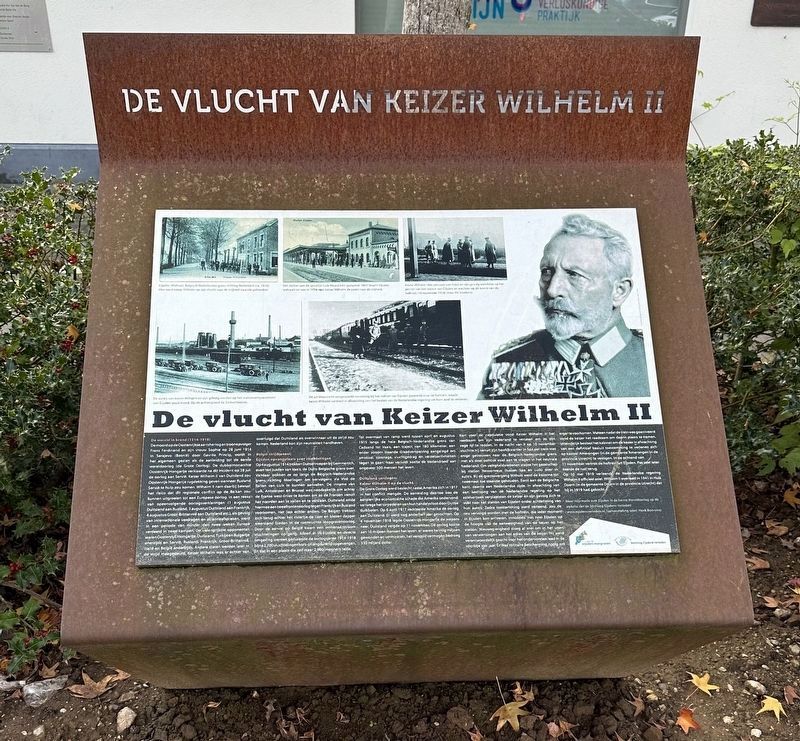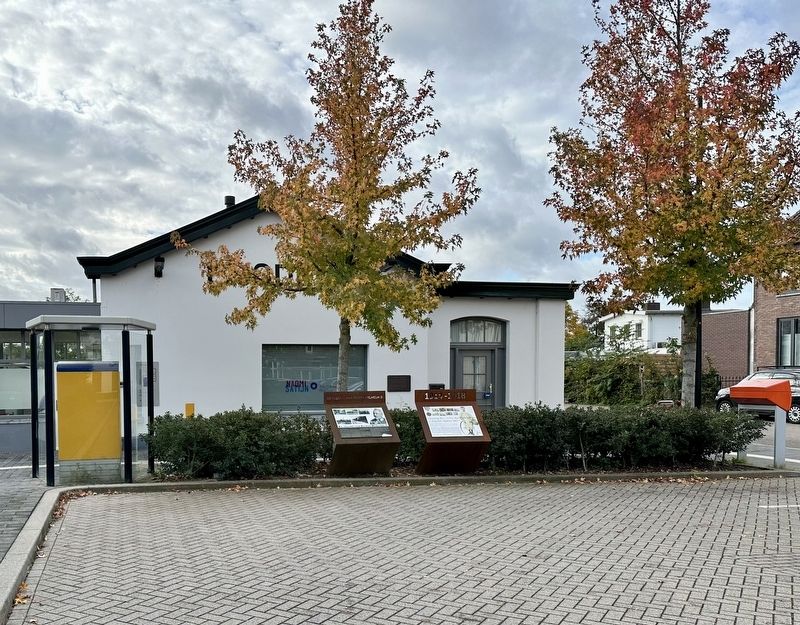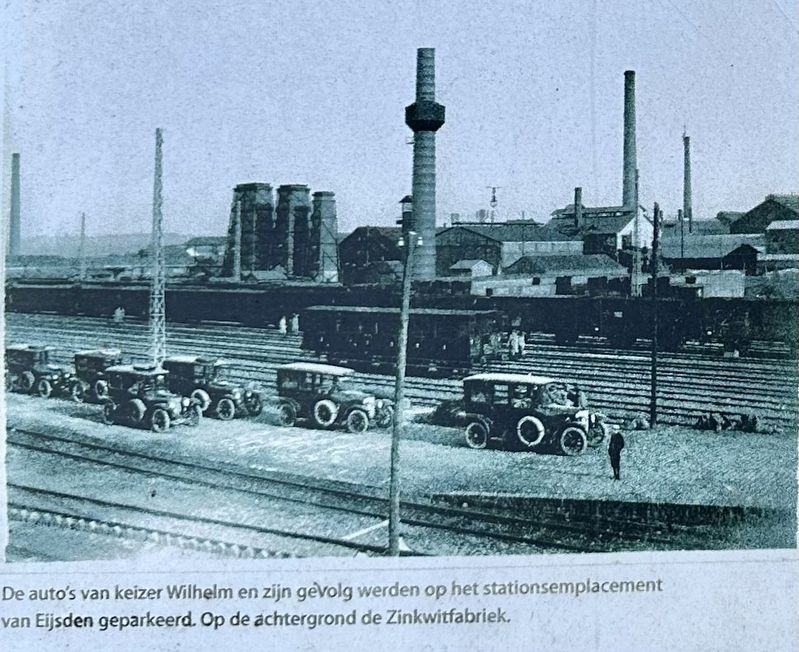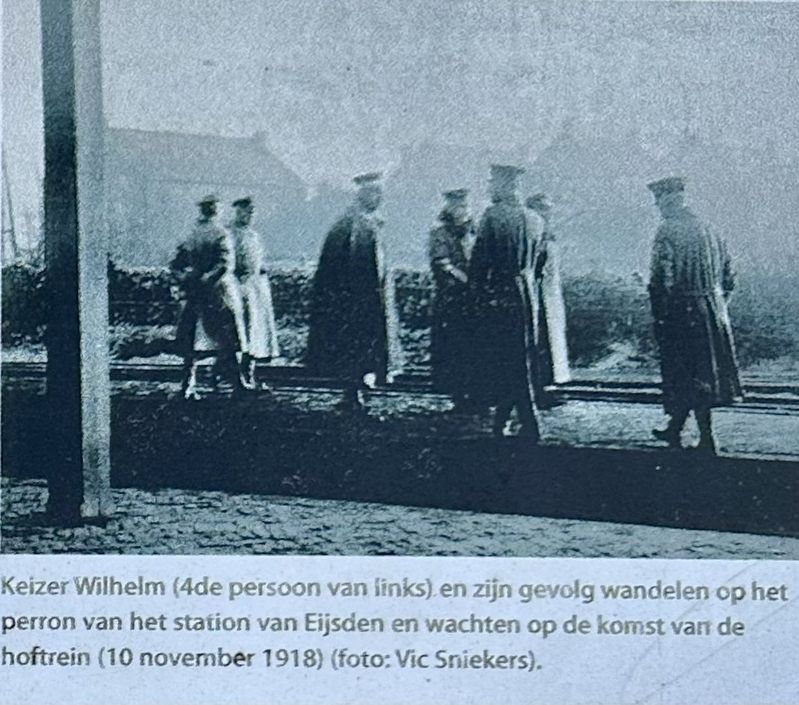Eijsden in Eijsden-Margraten, Limburg, Netherlands — Northwestern Europe
De Vlucht van Keizer Wilhelm II / The Flight of Kaiser Wilhelm II
Inscription.
De wereld in brand (1914-1918)
De moord op de Oostenrijkse aartshertog en troonopvolger Frans Ferdinand en zijn vrouw Sophie op 28 juni 1914 in Serajevo (BosniŽ) door Gavrilo Princip, wordt in het algemeen gezien als de aanleiding tot de eerste wereldoorlog (de Grote Oorlog). De dubbelmonarchie Oostenrijk-Hongarije verklaarde na dit incident op 28 juli de oorlog aan ServiŽ. Keizer Wilhelm II van Duitsland zou Oostenrijk-Hongarije rugdekking geven wanneer Rusland ServiŽ te hulp zou komen. Wilhelm II nam daarbij bewust het risico dat dit regionale, conflict op de Balkan zou kunnen uitgroeien tot een Europese oorlog. In een reeks van opeenvolgende oorlogsverklaringen (1 augustus Duitsland aan Rusland, 3 augustus Duitsland aan Frankrijk, 4 augustus Groot-BrittanniŽ aan Duitsland etc.), als gevolg van internationale verdragen en alliantieafspraken, werd in een periode van minder dan twee weken Europa verdeeld in twee kampen. De belangrijkste opponenten waren Oostenrijk Hongarije, Duitsland, Turkije en Bulgarije enerzijds en ServiŽ, Rusland, Frankrijk, Groot-BrittanniŽ, ItaliŽ en BelgiŽ anderzijds. Andere staten werden later in de strijd meegesleurd, Keizer Wilhelm was er echter van overtuigd dat Duitsland als overwinnaar uit de strijd zou komen. Nederland kon zijn neutraliteit handhaven.
BelgiŽ strijdtoneel:
Eijsden opvangplaats voor vluchtelingen
Op 4 augustus 1914 trokken Duitse troepen bij Gemmenich, even ten zuiden van Vaals, de Duits-Belgische grens over. Vandaar trokken ze op langs de Belgisch-Nederlandse grens richting Moelingen om vervolgens via Visť de forten van tuik te kunnen aanvallen. De inname van Luik, Antwerpen en Brussel was noodzakelijk om achter de Franse west-linies te komen om zo de Fransen vanuit het noorden aan te vallen en te verslaan, Duitsland wilde hiermee een tweefrontenoorlog tegen Frankrijken Rusland voorkomen. Het liep echter anders. De Belgen trokken zich terug achter het riviertje de IJzer en bleven dapper weerstand bieden in de roemruchte loopgravenoorlog. Door de aanval op Belgie kwam een immense stroom vluchtelingen op gang. Afleen al in Eijsden en directe omgeving werden gedurende de oorlogsjaren 1914-1918 bijna 2.700 vluchtelingen kort- of langdurend opgevangen. En dat in een plaats die zelf maar 2.900 inwoners telde.
Tot overmaat van ramp werd tussen april en augustus 1915 langs de hele Belgisch-Nederlandse grens var Cadzand
tot Vaals, een traject van 180 kilometer, eer
onder stroom staande draadversperring aangelegd om
smokkel, spionage, vluchtgedrag en verzetsactiviteiter
tegen te gaan. Naar verluidt kostte de 'dodendraad' aar
ongeveer 500 mensen het leven.
Duitsland verslagen:
Keizer Wilhelm it op de vlucht
De Grote Oorlog werd beslecht nadat Amerika zich in 1917 in het conflict mengde. De aanlťiding daartoe was de aanzienlijke economische schade die Amerika ondervonc vanwege het torpederen van hun handelsvloot door Duitse duikboten. Op 6 april 1917, verklaarde Amerika de oorlog aan Duitsland. Er werd nog anderhalf jaar gevochten. Op 4 november 1918 legde Oostenrijk-Hongarije de wapens neer, Duitsland volgde op 11 november. De oorlog kostte aan 10 miljoen mensen het leven, erwaren twintig miljoer gewonden en verminkten, het verspild vermogen bedroeg 330 miljard dollar.
Kort voor de capitulatie vond Keizer Wilhelm II het raadzaam om zijn vaderland te verlaten om zo zijn vege lijf te redden. In de nacht van 9 op 10 november vluchtte hij vanuit zijn hoofdkwartier in Spa per trein met enige getrouwen naar de Belgisch-Nederlandse grens met als doel politiek asiel aan te vragen in het neutrale Nederland. Om veiligheidsredenen stapte het gezelschap bij station Nessonvaux (tussen Spa en Luik) over in auto's. Bij de grensovergang Withuis werd
de kolonne tot
tweemaal toe staande gebouden. Eerst aan de Belgische
7 kant, daarna aan Nederlandse zijde. In afwachting van
een beslissing van de Nederlandse regering op het
de asielverzoek verplaatsten de keizer en zijn gevolg zich te
voet naar het station van Eijsden onder achterlating van
hun auto's. Zodra toestemming werd verleend zou de
reis vervolgd worden met de hoftrein, die ieder moments, in Eijsden kon arriveren. Inmiddels was heel Eijsden op
de hoogte van de aanwezigheid van de keizer op het
n station Nieuwsgierigheid sloeg al snel om in het uiten
van verwensingen aan het adres van de keizer. Hij werd
verantwoordelijk geacht voor het ondervonden leed in de
voorbije vier jaar. Er was militaire bescherming nodig om
erger te voorkomen. Meteen nadat de trein was gearriveerd
vond de keizer het raadzaam om daarin plaats te nemen.
Viteindelijk besloot het kabinet om de keizer in afwachting
van een definitief besluit toestemming te verlenen zich
op kasteel Amerongen (in de gemeente Amerongen in de
provincie Utrecht) te vestigen. In de ochtend van
11 november vertrok de hoftrei uit Eijsden. Pas veel later
keerde de rust terug.
Op 10 mei 1919 verleende de Nederlandse regering Wilhelm II officieel asiel. Wilhelm II overleed in 1941 in Huis Doorn (in de gemeente Doorn in de provincie Utrecht) dat hij in 1919 had gekocht.
Meer informatie
over Eijsden in de Eerste Wereldoorlog op de
website van de stichting Eijsdens Verleden:
www.eijsdensverleden.nl.
The Flight of Wilhelm II
The World in Flames (1914-1918)
The assassination of the Austrian Archduke and heir to the throne Frans Ferdinand and his wife Sophie on June 28, 1914 in Sarajevo (Bosnia) by Gavrilo Princip, is generally seen as the trigger for World War One (the Great War). The dual monarchy of Austria-Hungary declared war on Serbia on July 28 after this incident. Emperor Wilhelm II of Germany would end up backing Austria-Hungary, with Russia backing Serbia. Wilhelm II consciously took the risk that this regional conflict in the Balkans would develop into a European war. The series of successive declarations of war (August 1 - Germany on Russia, August 3 - Germany on France, August 4 - Great Britain on Germany, etc.), were the result of international treaties and alliances. In a period of less than two weeks Europe was divided into two camps. The main opponents were Austria Hungary, Germany, Turkey and Bulgaria on the one hand, and Serbia, Russia, France, Great Britain, Italy and Belgium on the other. Other states were later dragged into the battle, but Emperor Wilhelm was convinced convinced that Germany would emerge victorious. The Netherlands was able to maintain its neutrality.
Battlefield Belgium:
Eijsden as a shelter for refugees
On August 4, 1914, German troops moved near Gemmenich, just south of Vaals, across the German-Belgian border. From there they advanced along the Belgian-Dutch border towards Moelingen and then via Visť in order to attack the fortress belt. The taking of LiŤge, Antwerp and Brussels were necessary to get behind the French western lines to allow the Germans to attack and defeat the French in the north, with the intention of preventing a two-front war against France and Russia. However, things turned out differently. The Belgians retreated behind the IJzer River and remained brave in their resistance during trench warfare. The attack on Belgium created an immense flow of persons seeking refugee. Eijsden and the immediate area during the war years 1914-1918 received almost 2,700 refugees seeking short- or long-term shelter. And that in a place that itself had only 2,900 inhabitants.
To make matters worse, between April and August 1915, an electrified wire barrier was constructed along the entire Belgian-Dutch border from Cadzand to Vaals, a stretch of 180 kilometers, to prevent smuggling, espionage, refugee flight, and resistance activity. This 'death wire' reportedly killed around 500 people.
Germany defeated:
Emperor Wilhelm on the run
The Great War was settled after America entered the conflict in 1917. The reason for this was the considerable economic damage that America suffered due to the torpedoing of their merchant fleet by German submarines. On April 6, 1917, America declared war on Germany. Fighting continued for another year and a half. On November 4, 1918, Austria-Hungary laid down its arms, Germany followed on November 11. The war killed 10 million people, wounded and maimed 20 million, and wasted $330 billion in wealth.
Shortly before the capitulation, Emperor Wilhelm II thought it advisable to leave his homeland in order to save his life. On the night of November 9 to 10, he fled by train from his headquarters in Spa, Belgium, to the Belgian-Dutch border with some loyalists with the aim of requesting political asylum in the neutral Netherlands. For safety reasons, the group changed into cars at Nessonvaux station (between Spa and LiŤge). At the Withuis border crossing the column was stopped twice. First on the Belgian side, then on the Dutch side. While awaiting a decision by the Dutch government on the asylum request, the emperor and his entourage moved on foot to Eijsden station, leaving their cars behind. As soon as permission was granted, the journey would continue with the imperial train, which would arrive in Eijsden at any moment. Meanwhile, all of Eijsden was aware of the emperor's presence at the rail station. Curiosity soon turned into expressing curses against the emperor. He was considered responsible for the suffering experienced over the past four years. Military protection was needed to prevent worse. Immediately after the train arrived, the emperor thought it advisable to take a seat in it. Finally, the cabinet decided to grant the emperor permission to settle at Amerongen Castle (in the municipality of Amerongen in the province of Utrecht) pending a final decision. In the morning of November 11, the court train left Eijsden. Only much later did tranquility return.
On May 10, 1919, the Dutch government officially granted Wilhelm II asylum. Wilhelm II died in 1941 in Huis Doorn (in the municipality of Doorn in the province of Utrecht), which he had purchased in 1919.
More information about Eijsden in the First World War can be found on the website of the Eijsdens Verleden foundation: www.eijsdensverleden.nl.
Erected by Gemeente Eijsden-Margraten, Stichting Eijsdens Verleden.
Topics. This historical marker is listed in these topic lists: Immigration • War, World II. A significant historical date for this entry is May 10, 1919.
Location. 50° 46.335′ N, 5° 42.595′ E. Marker is in Eijsden, Limburg, in Eijsden-Margraten. Marker is on Stationsplein, on the left when traveling south. Touch for map. Marker is at or near this postal address: Stationsplein 9, Eijsden, Limburg 6245 AE, Netherlands. Touch for directions.
Other nearby markers. At least 8 other markers are within walking distance of this marker. Opvang Belgische vluchtelingen / Asylum for Belgian Refugees (here, next to this marker); Martin H. Wolfs Memorial (a few steps from this marker); Het Veldje / The Field (approx. 0.3 kilometers away); Von Dorpsstraat tot Diepstraat / From Dorpsstraat to Diepstraat (approx. 0.6 kilometers away); Aan de Laak / At the Border Water (approx. 0.6 kilometers away); Petrus Wolfs (approx. 0.8 kilometers away); Eijsden - Gronsveld Holocaust Memorial - De Breuk (ďThe BreakĒ) (approx. 0.8 kilometers away); Verzetsmonument Eijsden / Resistance Memorial Eijsden (approx. 0.8 kilometers away). Touch for a list and map of all markers in Eijsden.
Also see . . . Wilhelm II (Wikipedia).
The exile: Wilhelm first settled in Amerongen, where on 28 November he issued a belated statement of abdication from both the Prussian and imperial thrones, thus formally ending the Hohenzollerns' 500-year rule over Prussia. Accepting the reality that he had lost both of his crowns for good; he gave up his rights to "the throne of Prussia and to the German Imperial throne connected therewith". He also released his soldiers and officials in both Prussia and the empire from their oath of loyalty to him. He purchased a country house in the municipality of Doorn, known as Huis Doorn, and moved in on 15 May 1920. This was to be his home for the remainder of his life. The Weimar Republic allowed Wilhelm to remove twenty-three railway wagons of furniture, twenty-seven containing packages of all sorts, one bearing a car and another a boat, from the New Palace at Potsdam.(Submitted on November 20, 2023.)
Credits. This page was last revised on November 20, 2023. It was originally submitted on November 19, 2023, by Andrew Ruppenstein of Lamorinda, California. This page has been viewed 55 times since then and 15 times this year. Photos: 1. submitted on November 19, 2023, by Andrew Ruppenstein of Lamorinda, California. 2, 3, 4. submitted on November 20, 2023, by Andrew Ruppenstein of Lamorinda, California.



